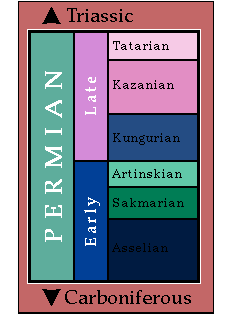



A standard global correlation of the Permian period has been undertaken only in recent years (Jin et al., 1994), since there are difficulties in correlation, especially within relatively newer strata. Until recently, there was little consensus on the order of strata in the Upper Permian. Since the upper strata of various locations lack numbers of fossils, correlation via index fossils must involve different fossils that are in some cases native only to the local regions where they were found, and older work had to use assumptions that have changed in more recent years (Menning, 1995; Jin et al., 1994). Even though knowledge of the Permian has increased, study of stratigraphic correlation still yields relatively new conclusions (Jin et al., 1994).
Older classifications relied on the Ural stratigraphy. An example of a recent effort to formulate a worldwide stratigraphy of the Permian period by Jin, et al. (1994) has four series: the Uralian, the Chihsian, the Guadalupian, and the Lopingian. These epochs include two or three stages each (ten in all). The names are derived from local areas -- the Uralian is named for the Urals, the Chihsian and the Lopingian are named for Chinese localities, and the Guadalupian is named for the Guadalupe Mountains of New Mexico, U.S.A.
 |
Permian: The chart at left shows the major subdivisions of the Permian Period. This chart is mapped, to allow you to travel back to the Carboniferous or forward to the Triassic. The Permian Period is part of the Paleozoic Era. |
Examples of localities noted for their Permian strata are found over several continents (Jin et al., 1994, Ross and Ross, 1995)
Permian shale, sandstone, siltstone, limestone, sands, marls, and dolostones were deposited by sea-level fluctuations. The fluctuation cycles can be seen in the layers of rock (Ross and Ross, 1995). Only a relative few sites lend themselves to direct radioactive dating, so the age of intermediate strata is often estimated (Menning, 1995). Radiometric dating may be used for certain sites, but other sites are not of sufficient quality to permit accurate dating, and other layers are dated in between layers where datable sites are located.
Permian fossils that have been used as index fossils include brachiopods, ammonoids, fusilinids, conodonts, and other marine invertebrates (Menning, 1995), and some genera occur within such specific time frames that strata are named for them and permit stratigraphic identification through the presence or absence of specified fossils.
Find out more about the Permian paleontology and geology of North America at the Paleontology Portal.

